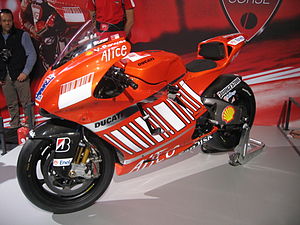Desmosedici RR

Casey Stoner's Desmosedici GP8 at EICMA 2008
|
|
| Manufacturer | Ducati |
|---|---|
| Also called | Ducati D16 |
| Production | since 2003 |
| Class | Prototype |
| Weight | 150 kg- (dry) 180 kg- (wet) |
| Fuel capacity | 21 l |
Ducati Desmosedici is the name of the series of four-stroke V4 Prototype Motorcycles developed by Ducati to compete in the MotoGP World Championship. GPx indicates the version of the bike, where x corresponds to the year the bike raced (i.e. the Desmosedici GP9 raced in 2009).
Ducati abandoned the Grand Prix racing scene at the start of the 1970s. For many years the 500 class was essentially a class for two-stroke motorcycles, an engineering technology that was far removed from the four-stroke road-going machines sold by Ducati. Technical rules changed in 2002, giving priority to four-stroke machinery and turning the 500 class of World Road Racing into the MotoGP Championship. This convinced Ducati to make a much-awaited return to the track in the new MotoGP class.
Ducati history is classically based on 90° V-twin (or L-twin) engines, using desmodromic valve technology. Initially, Ducati considered the possibility of creating a MotoGP ‘super-twin’, taking advantage of the MotoGP regulations that give twin-cylinder machines a considerable weight reduction over four, five or six-cylinder bikes. However, analysis indicated that a twin-cylinder engine would not have been able to produce the required amount of power, more than 230 hp (170 kW), without excessively increasing the number of revs. A twin would have had to rev at over 17000 rpm, but this would require a very short stroke and a very large bore, as a result producing possible combustion problems.
The basis of the design of the Desmosedici engine therefore is two classical Ducati L-twins next to each other, making a Double L-twin with two-cylinder Stroking at the same time (also called Twin Pulse). With four valves per cylinder, the total number of valves is sixteen - Desmosedici means desmodromic distribution with sixteen valves shortened in Italian.
Design had started in 2001, the bike was unveiled at the 2002 Italian GP at Mugello, for use in the following seasons MotoGP World Championship. Vittoriano Guareschi, the Ducati Corse test-rider, followed every phase of the Desmosedici’s development process from early testing to track debut and the project’s evolution. In 2007, Ducati's pilot Casey Stoner, riding a Desmosedici, obtained Ducati's first MotoGP World Championship Title.
...
Wikipedia
